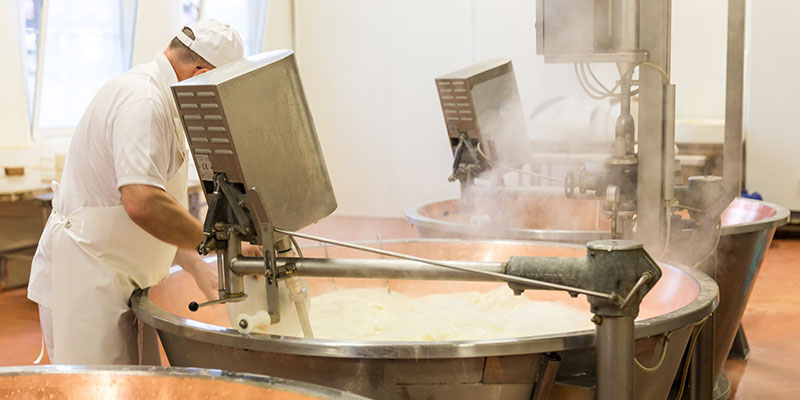Many food and beverage production processes, like cheesemaking, produce wastewater that’s particularly high in organic content, making it an ideal feedstock for waste-to-energy.
Food and beverage operations are ideally positioned to enter the circular economy with waste-to-energy systems
The food and beverage (F&B) industry is known for its high-load wastewater. In general, it’s estimated that wastewater sent to treatment utilities contains five times the energy needed to treat it, but the streams from F&B operations are often laden with fat, oil, and grease (FOG).
This could be considered a drawback, but fortunately there are processes that not only provide wastewater treatment, but also capture the latent energy held in the wastewater. Anaerobic digestion treats the high-load wastewater streams, which helps to protect the environment, while lowering utility bills and generating biogas – a renewable energy that can be used to power the process itself and more.
Biogas Production With Anaerobic Digestion
Anaerobic digestion uses microorganisms that thrive in oxygen-free environments to digest waste (feedstock) inside tanks. One byproduct of the process is methane, which rises to the top of the tank and is collected. The gas can be used as-is to fuel boilers or it can be refined further and sold in established markets. The leftover solids (digestate) are also marketable in agriculture.
The dairy industry is a good candidate for biogas production. Dairy plants have to deal with byproducts like whey, buttermilk, and wastewater from cheese processing. It can be difficult and costly to treat the effluent for compliance with discharge regulations. And, if a local wastewater utility treats the discharge, it may charge extra for the high organic load.
Fluence assisted an Italian dairy and cheese factory in dealing with its wastewater with an anaerobic digestion biogas recovery system, which has now been operational for nearly a decade. Every day the system produces 138 Nm3/h of methane, 12,000 kWh/d of electricity, and 12,500 kWh/d of thermal energy from the dairy’s wastewater and 180 tons/day of scotta-whey byproduct (whey from ricotta production). Solid digestate that’s left over from the process is used in agriculture.
This process helps the manufacturer meet effluent discharge standards, and more importantly, production wasn’t halted for installation or subsequent expansion of the system over the years.
True Sustainability
Although there is carbon in biogas, it’s considered a carbon-neutral energy source because the feedstocks used would be releasing their carbon into the atmosphere whether biodegrading naturally or being anaerobically digested.
In a landscape of questionable sustainability claims, waste-to-energy systems tower above most other initiatives. Biogas production from anaerobic digestion is the most productive waste-to-energy technology. With the positives of high energy yields, cleaner water, beneficial compounds for the soil, carbon footprint reduction, and free energy, you might wonder, “What’s the catch?”
So far, viability of anaerobic digestion systems has been contingent on the size of the operation. There must consistently be enough feedstock to warrant an anaerobic digestion system. In cases where there is insufficient feedstock, co-digestion (using different feedstocks together) is an option to improve return on investment. It’s common for several nearby operations from different industries to pool their waste to achieve critical mass for an anaerobic digestion plant.
Fluence has several successful anaerobic digestion systems in Europe and the Americas. Contact the experts at Fluence to discuss whether an anaerobic digestion biogas recovery system is a good fit for any given F&B operation. Also, Fluence can consult with clients on other feedstock options available in their area that might be successfully combined for co-digestion.

